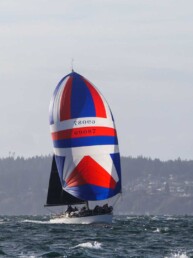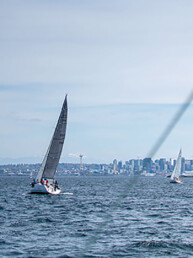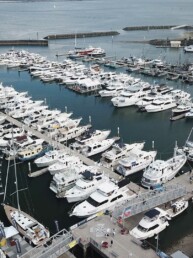Seattle Sailors and Moore 24 National Champions, Ben and Jennifer Braden headed down to California to tangle with some of the nation’s best.
To qualify for the US Sailing Championship of Champions, a sailor must win a national championship regatta in a US Sailing recognized one design fleet, and you still must apply to be invited to the regatta. Needless to say, it’s exclusive — and by winning our Moore 24 National Championship regatta down in Hood River, Oregon in 2018, we became eligible for application.
2018, you say? Yes, it’s an interesting story. Our Moore 24 Nationals regatta was held about one week after the cutoff date for application to the 2018 regatta, making it one of the first Nationals eligible for the 2019 Championship of Champions regatta — that year held in Connecticut on Ideal 18s. We applied but didn’t make the cut until about 2 weeks before the regatta. Too short of a timeline for us to make it happen unfortunately. Seattle sailors, Dalton Bergan and Ben Glass, won that event.
Roll in 2020 with all its challenges and lack of National regattas around the country, and wouldn’t you know it we were eligible again, and thankfully the regatta was to be held on the West Coast for the first time in many years. When you think about it, it makes sense the regatta would be held on the East Coast most of the time. It’s an area where the yacht clubs generally have their own fleet of single or doublehanded main-and-jib only boats, and the proximity of water and population centers are conducive to the US Sailing one-design fleet championship system.
Nonetheless, the 2020 Championship of Champions regatta was to be held in the Schock Harbor 20’s sailing out of Balboa Yacht Club in lovely Newport Beach, California October 8-10, 2020. The Schock 20 is a 2-person gentlemen’s boat consisting of a main and jib only with the jib on a boom to help downwind sailing. It’s a somewhat lightly-built, good looking inshore daysailer that has evolved into the local Newport Beach Harbor one-design fleet. No tiller extensions are allowed and you must race with cockpit cushions in place. Harbor 20 one-design rules allow for absolutely no hiking and you can’t leave the cockpit during a race to adjust the jib halyard or tack/clew settings.
Needless to say we were out of our element.
Our Moore 24 Nationals was won by racing three days in Hood River, Oregon with 20 to 30-plus knots of wind and those big waves that Swell City tends to throw at the sailboarders. Interesting tidbit — the Moore 24 fleet is still the only US Sailing-recognized one design keelboat fleet to hold a regatta in Hood River, Oregon. More have been held at that wonderful dinghy venue downriver in Cascade Locks, but I’m talking about that windiest of areas between Swell City and the Hood River event site and at times on down towards that even windier stretch of water east of the Hood River Bridge. But I digress.
So my wife, Jennifer, and I arrive in sunny southern California Thursday morning before the regatta, find our way to the beautiful Balboa Yacht club, check in and pull our first boat — Bow 18. It’s a rough boat, older sails and full of about 25 gallons of water (its’s amazing how much water can be in a Harbor 20 bilge and not be over the floorboards).
Thursday was practice race day, and we headed out into the harbor, away from the ocean, to the basin between Lido and Balboa Islands. The Race Committee set up a quick course and we all practiced and learned a bit about these little boats. Comments of “that would have been a foul if we were actually racing” were heard a couple times and after three practice races, one of which we finished. We learned one major thing — I had to be nicer to Jennifer, who was not in her normal role on the bow, but was acting as a jib trimmer on a boat with a jib boom.

That night we made sure we stocked up on libations to make the gentlemen’s boat complete. At the time, we had no idea how important this little feature was going to be. Friday dawned sunny and warm — I know, right … Southern California. Winds were out of the west to northwest (big shifts) and the course was set from almost touching Balboa Island, literally only two boats could pass each other side by side between the RC boat and dock to leeward. This feature pushed me to use a dip start more times than I can remember, which worked great actually — easy to get that boat up to speed off the start line with a dip start.
The weather mark was set at the start of the choke point. Imagine the bay shaped like a funnel and just when it gets down to the throat, that’s where you set the mark. A good five boat lengths off the dock, five boat lengths for the starboard approach. Think about that for a moment. Nineteen boats sailed by national champions — good, competitive sailors — converging on a space that can handle five boats at about the same time.
I dubbed Friday the “Smash and Bash Championship”. I’ve not seen so many collisions, so many sailors yelling, and so few circles in my life. We honestly didn’t have much of an option when you got to the weather mark. Everyone chose to not hit the dock, but rather each other and marks were fair game. After doing a few circles myself, I realized that I was in the minority of sailors out there by doing them.
When I looked back on it a few days later, it really was the Race Committee’s fault we all were forced to violate the mark rounding rules. By setting the mark up at the end of the funnel throat instead of the beginning of it, they could have created the separation needed for clean rounding’s. A learning experience. We often found ourselves at the weather mark in the top 10 Friday, but I wasn’t willing to push the rules, or completely ignore them, which turned out to be a hindrance. We finished the day in 19th place out of 19. DFL.
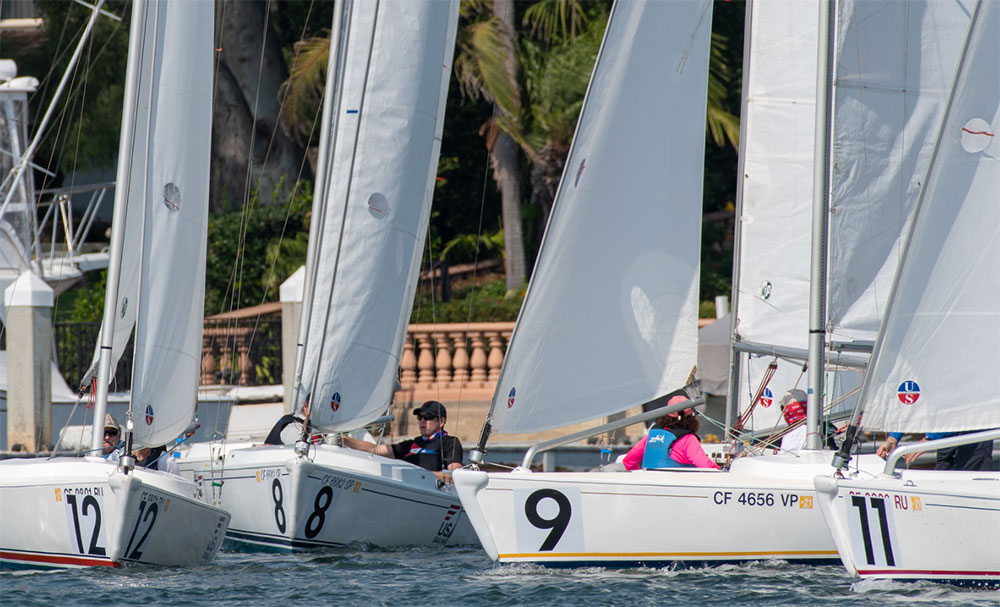
I’d like to say the sail back to the yacht club was a sobering one, but the reality was exactly the opposite. We decided if the racing was like this Saturday we would take a tour of the bay and maybe go sightseeing instead.
The best part of this regatta was meeting and talking with the competitors and event organizers. We loved getting to know Walter and LeeAnn, the great people from EV Yachting who organized the regatta and were tireless trying to make everyone happy and welcome. Hanging out with Stan and Sally Honey, meeting Augie Diaz, learning about the new young up-and-comers — this was a treat we didn’t expect.
Saturday’s race course was set much better. I’m told someone mentioned protesting the race committee for forcing all these boats to violate rule 18.3, but maybe that was just rumor. Anyway, they set the start line with room below it and set the weather mark a bit back from the choke point and all the way to the left side so there was a nice starboard approach, room for boats to find an opening or simply have an opportunity to find the back of the line if they had to. No collisions, no yelling, clean racing. Absolutely refreshing after Friday, and it kept us in the game. A few top 5 finishes for us, and by the end of the day we had worked up to 16th with a huge point gap in front of us to make 15th.

We did have one amazingly odd weather rounding. The Race Committee has a couple “patrol” boats out there on the course to direct traffic away from the marks. They keep the Duffy’s — those little electric boats that rent for an hour or a day to anyone that comes along — out of the way. Every day there were 20+ of them scooting around with every type of party imaginable aboard, kids’ birthdays to 21 runs. There were also bar boats motoring around the bay, basically a tiki bar set up on a barge with an outboard — full party. But thankfully these had captains aboard, so they were never an issue on the course. The Duffy’s, a whole other story.
In this odd rounding, we came into one weather mark in probably 6th or 7th and saw a Duffy sitting just below and to the right of the weather mark. The leaders were rounding and yelling at the Duffy to stay where they were, “don’t move!” The patrol boat was there but sitting to weather of the mark not doing much of anything. We tacked to starboard and when I looked up from the tack I was moments away from t-boning the Duffy that obviously hadn’t stayed where they were told to stay and tried to power through. I threw the helm up and coasted head to wind while the hapless father driving the Duffy did little to nothing to get out of the way — total deer in the headlights. I had to instruct him on how to power up and get out of the way while 6 or 7 boats got ahead of us and rounded the mark. His wife looked me and said “Everyone can use the harbor, we don’t have to get out of your way!” Oh my, basic Col Reg’s instructions could be good for the Duffy rentals…
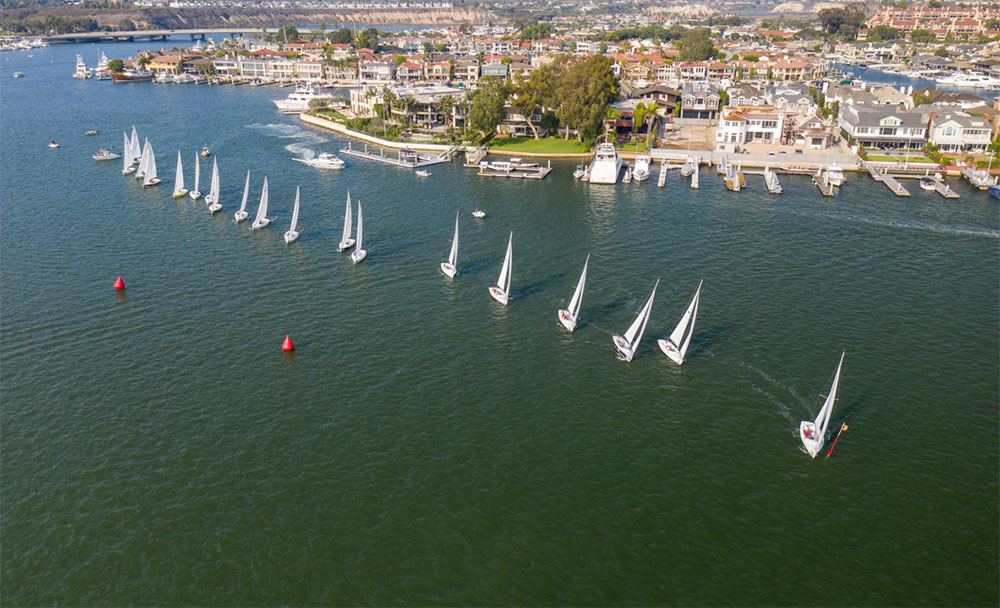
Needless to say we didn’t do well in that race, but this was the moment I met Augie Diaz — one of the world’s most amazing Star sailors — as he ran into my transom and proceeded to barge between me and mark while I was getting back up to speed from the Duffy incident. Nice guy, though — he did a circle for the foul after a short discussion and even joined me to ask for redress the next morning. Unfortunately, the redress was tossed out as I missed the 20 minute time limit to file after racing due to helping people dock and putting the boats away. Apparently, some rules were followed at this regatta after all.
One thing I didn’t mention earlier is that this was a round robin regatta, meaning we trade boats after every 3 races. They had a 40-foot dock anchored out near the approach to the weather mark and every third race we finished at the weather mark and got in the queue for rotation. Pull up to the dock, mask up, throw your gear on the dock and then spray the boat down with disinfectant cleaners, wipe it off and jump on the next boat. Honestly, this was the best run program at this regatta — the volunteers really did a great job of making sure we had clean, safe and quick transfers of boats.
The organizers made every attempt to keep the boats as similar as possible before the regatta but there is only so much they can do here as the boats were not built with a strict one-design philosophy in mind. Jib boom end heights ranged from 6 to 12 inches off deck, some boats had motors, sails were different ages — each boat had to be sailed differently. Some I could figure out and, frankly, some I could not and we just felt slow through the water and couldn’t compete. In a fleet of this many good sailors, the littlest thing would send you out the back.
Saturday we thankfully learned about one of the treasures of sailing with this group — the pairing of Chris Raab and Rob Kinney. Remember in the Muppets, those two guys that would bicker at each other incessantly? I think the writer for the Muppets got the idea from Rob and Chris. We found ourselves changing which leeward gate mark we would round so we could do it near Chris and Rob. Yes, it didn’t help us and they would quickly pull away from us as we were laughing our butts off after hearing their interactions. Truly a gem those two, and they finished second overall.
Saturday’s racing was followed by the regatta dinner on the patio between the yacht club and the docks. While listening to a great presentation by Stan Honey about the upcoming mixed doubles racing in the Olympics, we took pause as the sun was setting over the ocean and struck the colors from the yacht club yardarm with all the proper pomp and circumstance associated with this valuable moment. I know many yacht clubs and organizations do this around the country, but it’s not something I experience much outside of the Elks here in the PNW. Crap, it’s often hard to tell when the sun is setting most of the year in the PNW! It was special to be part of that for a few nights while at Balboa Yacht Club, thank you and well done.
Sunday dawned with the lightest conditions we’d seen yet. We were not too optimistic about the day, and when someone mentioned that there was a political rally scheduled for boats in the harbor that day, any optimism about good racing disappeared. Visions of overloaded powerboats making big waves and flamboyantly parading around the harbor flashed in my head. I was kinda looking forward to watching and experiencing it, but it didn’t materialize — only a few anchored, flag-flying flotillas showed up.
So racing ran again in that shifty light harbor breeze. A few more races, a couple boats I couldn’t make go well, and we were solidly locked into 16th place for the weekend. Not that I had a lot of expectations for this regatta in these particular boats but as competitors you always try and always want to succeed no matter what you are racing. I’d be lying if I told you I didn’t feel bad about 16th place, yet when you consider the great competition and the number of teams that have sailed together for years on boats just like these we probably did about as well as were able to.
We ended the weekend with a leisurely sail out past the yacht club to the edge of ocean to say that “Yes, we can sail these things on the ocean!” Then back to the Yacht Club to put our gentlemen’s boat away and cheer on the victors in 2020 US Sailing Championship of Champions regatta — truly an experience we’ll remember for years and one I am happy to have in my memories, even with the hardships on the water and poor final finish. The people I met, the efforts of the volunteers, watching the sun set gracefully at the edge of the ocean, that’s why we do this, those are the treasures of the sailing lifestyle.
Photos all taken by and provided courtesy of Tom Walker Photography
Ben Braden
Ben Braden is a Bainbridge Island native who has been sailing the Pacific Northwest his entire life. He is a broker for Sail Northwest, is very active with the Ballard Elks, and can be found racing his Moore 24 up and down the West Coast with his wife, Jennifer.

